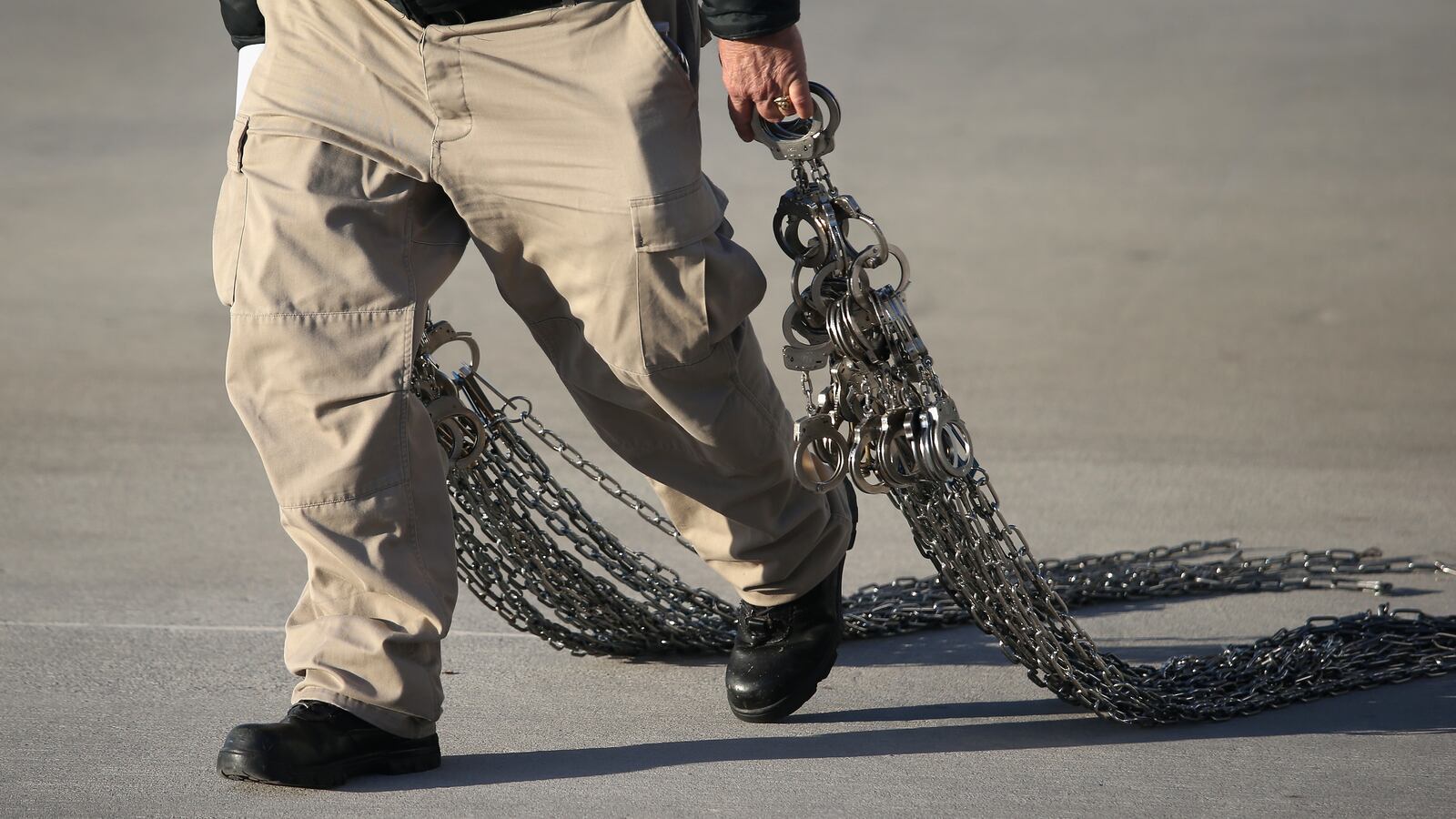An ICE detainee from Yemen being held in a privately run Arizona jail has been on a hunger strike for nearly a month, skipping some 73 meals and losing almost 17 percent of his overall body weight as of Friday.
Authorities on Friday asked a judge to allow them to force-feed the 26-year-old man through a plastic tube inserted up his nose and down to his stomach—a practice the American Medical Association (AMA) considers a form of torture.
In federal court filings first obtained by The Daily Beast, the U.S. government requested permission from a judge to “involuntarily administer nutrition” to Hamad Mohsen Thabit Saad Sayad through “placement of a nasogastric tube,” citing an osteopath on the ICE payroll who “opines that medical soft restraints [may be] necessary to prevent injury both to Mr. Sayad and to medical staff.”
On Feb. 18, a U.S. district court judge granted ICE’s request, ruling that the Department of Homeland Security can begin force-feeding Sayad and giving the agency permission to physically restrain him if he resists.
Sayad’s court-appointed lawyer, Christopher Thomas, declined to comment for this story.
More often than not, force-feeding orders are filed in secret against people who do not have attorneys to help them through the process, ACLU attorney Eunice Cho told The Daily Beast, describing the process as little more than a “rubber stamp” that gives the government permission to implement “extremely coercive and unethical procedures on people without true due process, where the individual really has no real way to contest what is happening in court.”
In its filings, government lawyers argue, “These measures are medically necessary [to] prevent further injury, dehydration, other and permanent damage up to and including death.”
But, according to the World Medical Association, “Forced feeding is never ethically acceptable. Even if intended to benefit, feeding accompanied by threats, coercion, force or use of physical restraints is a form of inhuman and degrading treatment. Equally unacceptable is the forced feeding of some detainees in order to intimidate or coerce other hunger strikers to stop fasting.” The AMA says force-feeding, as a practice, goes against the “core ethical values of the medical profession.” And in the face of widespread opposition to the practice, the United Nations said force-feeding by ICE could violate the U.N. Convention Against Torture.
On Tuesday, Sayad was given a partial victory in court. Although he remains unsteady on his feet due to his refusal to eat, and his body is now consuming its fat stores to stay alive, a CoreCivic doctor in a status update deemed Sayad’s condition “sufficiently stable” as he has “sipped small amounts of water” and drank a nutritional supplement on Sunday. Because he has become “mostly compliant,” Sayad will not be force-fed yet—but will be “involuntarily” hydrated for at least the next 48 hours, with the use of restraints, if necessary. Doctors will continue to monitor Sayad, pending lab results due Thursday, according to a status report filed in federal court.
CoreCivic did not respond to a request for comment. An ICE spokesperson acknowledged The Daily Beast’s request for comment, but had not provided a statement by the time of publication.
Sayad, who tested positive for COVID last month, has been detained at Arizona’s La Palma Correctional Center since Dec. 16, 2020, and currently has an appeal pending with the Department of Justice’s Board of Immigration Appeals, according to the filing. His health is rapidly declining, and Sayad has already been hospitalized twice since beginning the strike.
Before starting a force-feeding regimen, ICE’s filing says the agency would like to “conduct involuntary blood draws and weight checks, insert urinary catheters, and perform routine medical examinations” on Sayad, and “restrain [him] if he resists.” Urinary catheterization involves inserting a tube into the urethra, and can cause “pain, bleeding, infection, and damage to surrounding structures, including vital organs,” according to the ACLU and Physicians for Human Rights (PHR).
Forced urinary catheterization is considered illegal under international law, and in 2020 was declared unconstitutional by a federal judge in South Dakota. Cho, who last year co-authored a report titled: “Behind Closed Doors: Abuse and Retaliation Against Hunger Strikers in U.S. Immigration Detention,” called hunger strikes a last resort for those who have exhausted all other options. Yet, according to Physicians for Human Rights and the ACLU, ICE has oftentimes “failed to consider alternatives to force-feeding, including resolving hunger strikers’ basic requests for improved conditions.”
ICE has tried to implement different mechanisms for detainees to lodge grievances, Cho told The Daily Beast, calling the current complaint procedures little more than “window dressing” that ultimately leads people to extreme measures as they wait for their immigration cases—which are generally civil, not criminal matters—to make their way through the system.
“People could very well be safely awaiting these proceedings, which can sometimes take months, if not years, in the safety of their own home and community,” Cho said. “And instead, people are being held in these conditions, where medical needs are not being met, where there’s abuse, where there are repeated complaints about all kinds of conditions—the least of which is the astronomical spread of COVID-19… You can see why people who are in detention themselves are questioning not only the conditions of detention in the first place, but actually even the fact of their detention in the first place.”
ICE says medical staff at La Palma have informed Sayad, through an interpreter, that his hunger strike could have deadly consequences. He has been evaluated by a psychologist, “who did not find that he suffered any sort of psychiatric condition that would prevent him from eating or drinking,” ICE’s filing states.
Sayad has exhibited an “inability to stand due to headaches and dizziness; unsteadiness on feet and having to sit after approximately two minutes of standing; and no measurable urinary output,” the filing states.
“Now that Mr. Sayad is on day 24 of his hunger strike, he is expected to continue to decline and may suffer neurological symptoms,” it continues. “He has already suffered serious enough symptoms as to require hospitalization twice,” noting that ICE medical staff “is concerned that Mr. Sayad is in imminent danger of renal failure, liver failure, or becoming comatose due to dehydration and hypotension, which would lead to death.”
The 2021 analysis by the ACLU and Physicians for Human Rights identified a half-dozen instances of force-feeding by ICE at Texas detention centers between 2013 and 2017. In 2019, five hunger striking asylum seekers were force-fed at an ICE facility in Louisiana, according to Freedom for Immigrants, which says many hunger strikers are protesting “lengthy periods of detention in inhumane conditions, and arbitrary denial of parole and bond as a motivation.” That same year, ICE acknowledged the involuntarily feeding of six detainees in Texas, and one in Arizona.
In the Arizona case, 44-year-old detainee Aamir Hafiz Sheikh reportedly refused to eat when Pakistani officials slow-walked a U.S. request for a travel document necessary for ICE to deport him. A judge granted the agency permission to force-feed Sheikh, a small business owner convicted of food stamp fraud in 2015 and ordered deported.
Still, not all hunger strikers are force-fed. In another Arizona case, ICE eventually switched one striker’s housing assignment, “the demand underlying the hunger strike, averting the need for force-feeding,” according to Just Security.
A hunger strike is considered constitutionally protected speech under the First Amendment. In a 1990 decision, U.S. Supreme Court Justice William Brennan wrote, “The passive nonviolence of King and Gandhi are proof that the resolute acceptance of pain may communicate dedication and righteousness more eloquently than mere words ever could. A boycott, like a hunger strike, conveys an emotional message that is absent in a letter to the editor, a conversation with the mayor, or even a protest march.”
As immigration lawyer Stephanie Norton told The Daily Beast, “This is really the only speech that they have. It’s the only power that they have to protest against the way that they’re being treated.”
In Sayad’s instance, ICE claims in its court filing that he is “not claiming a constitutional right to starve himself or refuse medical treatment, but rather…it appears that he is attempting to manipulate the system—that is, to alter his classification, and/or secure his release from detention by starving himself until ICE officials acquiesce to his demand.”
The agency goes on to say that Sayad is risking his life by “making it impossible for the United States to fulfill its responsibility to provide adequate treatment and care to him,” and that his actions may “have a significant destabilizing impact on the institution.”
“If prisoners are allowed to kill themselves, prisons would find it even more difficult than they already do to maintain discipline, because of the effect of a suicide in agitating other prisoners,” states the filing, while noting that the government “has a legitimate interest in avoiding unnecessary and burdensome litigation,” such as a federal civil rights suit for allowing Sayad to die.
It also explains that ICE fears Sayad’s situation could influence other detainees to go on hunger strikes in an “attempt to manipulate the staff to gain various benefits and privileges. For example, detainees may initiate hunger strikes to pressure staff to transfer them…or to gain their release from detention. Without the ability to intervene when medically necessary, [ICE] will be forced to choose between letting the detainee die and giving in to his wishes.”
To Norton, the binary choice between two extremes—ceding to a detainee’s demands or letting them die—is the wrong way to frame the issue, she told The Daily Beast: “Really it should be about, how did we get to this point where this person is so desperate? That he feels like this is the only option he has? And how has the system failed him up to this point?”
Although Norton, who works at Seton Hall University Law School’s Immigrants’ Rights Clinic, is not involved with Sayad’s case, she does represent a hunger-striking detainee in ICE custody. Her client, Luis Diaz, participated in a hunger strike last March and is currently striking again, Norton told The Daily Beast.In a letter sent to ICE administrators earlier this month and shared with The Daily Beast, Norton, along with a pair of immigration advocates and a medical doctor, noted that while Diaz was striking the first time, ICE officials “allegedly told Mr. Diaz that they would ensure he would never be released.” His request for release on medical grounds was subsequently denied, after which he was transferred to Miami. Despite his subsequent diagnosis with a serious heart condition, ICE has continued to deny his release, Norton said.
Diaz was placed in solitary confinement when he began his hunger strike, he told The Daily Beast in a Tuesday phone call from the Miami lockup. He is now isolated in a medical unit without any contact with other detainees, Diaz said.
Joanna Naples-Mitchell, a human rights lawyer, U.S. researcher at Physicians for Human Rights, and co-author of Behind Closed Doors, said that when area hospitals refuse to assist in force-feeding, ICE usually turns to contractors instead “in contravention of very clear medical ethical guidelines.” And ICE’s description of force-feeding as a medical necessity to avoid unnecessary deaths is something of a red herring, Naples-Mitchell told The Daily Beast.
“If they were really concerned about that, then they would be making systematic efforts to improve conditions across the board,” she said. “The fact that they’re suddenly worried about someone who’s on hunger strike dying in custody, when they haven't shown any similar concern for the many, many people who have died in ICE custody, really shows how suspect that concern is.”






